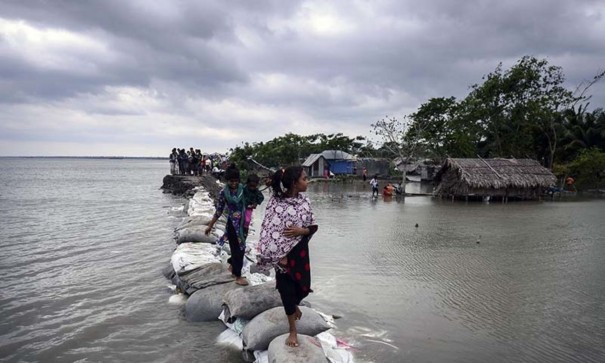Bangladesh is highly vulnerable to climate change impacts because of its vast low-lying areas, large coastal population, high population density, inadequate infrastructure, and high dependence on natural resources. For Bangladesh, climate change manifests both as changes in the severity of extreme events and in greater climate variability. Climate variability is manifested by more pronounced variation of wet and drought years, whereas extreme weather events manifest through stronger tropical cyclones which also generate more powerful storm surges, and whose effects are amplified by the effects of rising sea levels. About 20% of the population lives in the low coastal zone and any increase in sea level will have enormous negative effects. Because of the flat topography, even small increments in sea level rise will affect large areas, directly through inundation and salt intrusion.
Against this backdrop, this study explores the possible impacts of climate change on the economy of Bangladesh, during 2015 and 2100, using a dynamic CGE model through projected changes in different parameters as provided in the ADB (2014) study. Our study considers a combined effect of six climate change scenarios: (i) the impact of climate change on paddy yield in Bangladesh in 2030, 2050 and 2080; (ii) permanent inundation of 0.90% of Bangladesh’s dry land as a result of sea-level rise; (iii) annual reduction in labor supply due to mortality and morbidity until 2100; (iv) depletion of capital stock in the construction sector by 0.05% annually until 2100; (v) annual reduction in the surplus of water until 2050 and beyond that; and (vi) annual rise in the excess demand for electricity during 1930s and 1950s and beyond that.

The impacts on real GDP, exports and consumer price index (CPI) show some large effects of climate change on these indicators. Compared to the business as usual (bau) scenario, set in the dynamic CGE model, real GDP would fall by 4.31% by 2030, around 6% by 2050, 7.3% by 2080, and close to 8% by 2100. There would be a negative impact on exports, as exports, compared to the bau scenario, would fall by 3.7% by 2030, 5.4% by 2050, 6.7% by 2080, and more than 7% by 2100. There would also be inflationary pressure on the economy, like CPI, compared to the bau scenario, which would rise by 2.5% by 2030, 3.7% by 2050, 4.9% by 2080, and 5.6% by 2100. All these figures show very large costs to the economy of Bangladesh.
What should be the adaptation strategies? The ADB (2014) study suggested a number of adaptation strategies. In the case of drought, the adaptation strategies include introducing drought-tolerant crops, efficient use of water, use of surface water for irrigation and more plantation. In the case of flooding, the suggestions include introducing short duration and flood-tolerant crop varieties, promoting community-based seed preservation, introducing raised seedbed in highlands and floating seedbeds in low-lying areas, and constructing flood friendly infrastructure. To adapt to the changes in weather, suggestions include an emphasis on heat and cold tolerant crop varieties, practicing Integrated Crop Management, and creating options for reserving surface water for irrigation. To protect riverbank erosion, suggestions include constructing and maintaining relevant infrastructure and plantation. In the case of sea-level rise, the suggestions include promoting community-based open water fisheries, and alternative options of aquaculture (e.g. cage aquaculture, pen culture, crab fattening, etc.). In the case of salinity intrusion, the adaptation strategies include the domestication of saline and brackish water fish species, constructing and rehabilitating climate-resilient water infrastructure, introducing saline tolerant crops and vegetable variety.
The adaptation strategies in the case of health should include water treatment facilities, surveillance and monitoring of conditions favorable for disease outbreak, improve public education especially in reproductive health and technological/engineering controls for pests. In the case of water, broad adaptation measures include strengthening field bunds to conserve more rainwater, re-excavation of traditional ponds, re-excavation of small canals and other water conveyance structures, the building of water control structures, check dams across the waterways, construction of mini-ponds, shallow and deep tube wells. The major adaptation strategies for infrastructure include repair and maintenance of existing flood embankments, repair and maintenance of existing cyclone shelter, planning, design, and implementation of resuscitation of networks of rivers and canals through dredging and de-siltation work, repair and maintenance of existing coastal polders, improvement of urban drainage adaptation against floods, and adaptation against future cyclones and storm-surges and planning, design, and construction of river training works.
Reference
ADB (2014), “Assessing the Costs of Climate Change and Adaptation in South Asia”, Mandaluyong City, Philippines: Asian Development Bank



RECENT COMMENTS